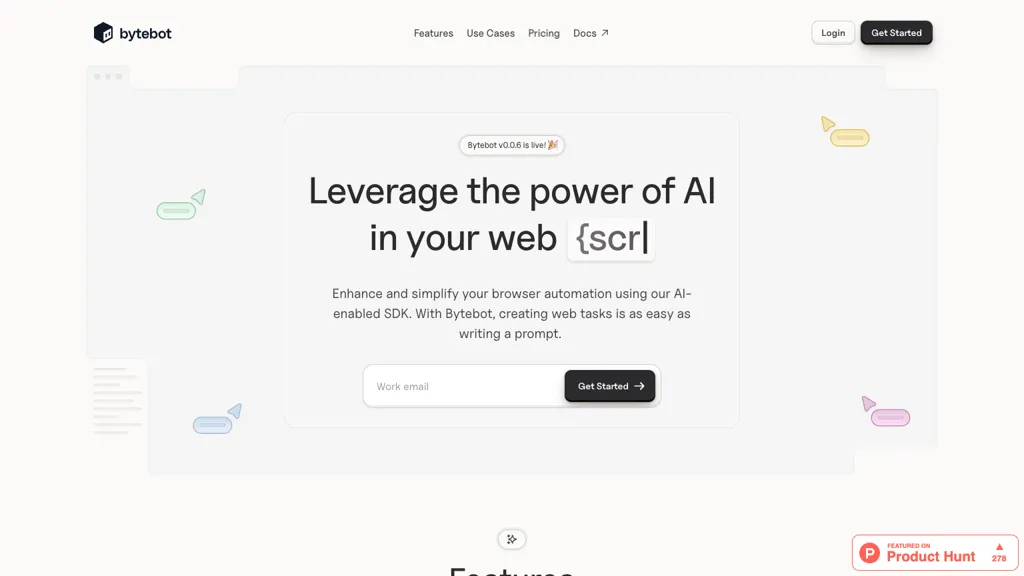What is Bytebot?
Bytebot is an AI web tool that helps improve workflows by removing activities that require automation, testing, and monitoring tasks. It’s their latest version of Bytebot v0.0.6, by which you can now very easily automate the browser with their AI-driven SDK. Now, one can make web tasks using their natural language prompts.
It provides the execution of web tasks, interpreting natural language commands to puppeteer commands and running tasks extremely fast. Bytebot gets rid of traditional coding in setting up browser automations, allowing a more intuitive way. Dynamic adaptation ensures that automation processes are not disrupted in the case of changes to the website layout. Its applications would be mainly automated data extraction, dynamic form filling, submissions, and continuous website monitoring and reporting.
Key Features and Benefits of Bytebot
It is versatile through its offered features and benefits, making it usable flexibly across multiple users and applications. Some key features include:
- Web scraping
- Automation
- Testing
- Monitoring
- Natural language prompts
Such features of Bytebot add to its value in terms of efficiency, real-time monitoring, and the elimination of complications in traditional coding. The use of natural language prompts allows for easy and intuitive task creation, which the user with varied levels of technical expertise can have access to.
Use Cases and Applications of Bytebot
There are many realistic situations that create efficiencies and accuracies in the use of Bytebot. A few of them include:
- Use Bytebot’s AI-driven SDK and build out demanding web-scraping tasks easily by extracting information from multiple websites simultaneously.
- Increase efficiency in dynamic form filling through natural language prompts in browser automation using Bytebot, thus smoothing interactions between web forms and databases.
- With Bytebot, you can monitor website changes in real-time and receive auto-generated reports, ensuring a continuous vigilance and immediate alerting of any changes or problems with the websites under surveillance.
The benefits and characteristics of Bytebot help industries and sectors involved in web development, data analysis, quality assurance testing, and automation engineering. Considering the flexibility and ease of use of Bytebot, professionals dealing with the above mentioned fields can use it as a versatile tool.
How to Use Bytebot
Using Bytebot is really a breeze, thanks to its user-friendly dashboard and natural language prompting. Below are steps to take in getting started:
- Sign up and subscribe to any of the Bytebot plans.
- Login to your Bytebot dashboard.
- Explore the interface.
- Define and create your web tasks using the natural language prompting feature.
- Finally, run your defined tasks and track their progress.
- Review performance and tweak the tasks to enable perfect execution.
Best practice is to update the tasks periodically, because changes in website structures are frequent. It is also best practice to set monitoring on Bytebot so you can get noticed whenever changes or problems happen on your tasks.
How Bytebot Works
Bytebot operates by processing natural language commands, using advanced AI algorithms that change them to puppeteer commands, and thereafter, executing those commands in executing different web tasks. The technology is powered by a machine learning model that is established in understanding and processing natural language inputs, in the firm execution of tasks.
The workflow is initiated with the user giving the natural language prompts associated with the definition of what tasks are desired. Bytebot further translates the prompts into an executable command, runs these tasks, and then hands back the results made in its friendly user interface. More importantly, this process does not require any traditional elements for coding; therefore, web automation is open to a much wider class of users.
Pros and Cons of Bytebot
As with any other tool, Bytebot also possesses some pros and cons associated with its usage. They are as follows:
Pros:
- Intuitive natural language prompts to make tasks
- Eliminates old school coding
- Real-time monitoring and reporting
- Dynamic adaption to any changes in website layouts
Cons:
- May not be affordable for all users as it is available with a subscription-based pricing
- It has to be continuously updated with new technologies in the web world
On the whole, the customer’s response to Bytebot is very good, primarily because it is user-friendly and fast to automate routines associated with using the web.
Conclusion about Bytebot
In summary, Bytebot is a strong AI tool for making web workflows with automation, web scraping, testing, and monitoring run fast. Its user interface is friendly, designed in a way that it works easily with natural language prompts and dynamic adaptability in order to be useful to users, such as web developers, data analysts, QA testers, and other automation engineers. This is not that affordable for everyone because of the payment based on subscription, but the value and efficiency are so much appreciated and invested in reinforcing the web automation ability.
A lot more is coming to ensure that Bytebot stays atop in web automation technology.
FAQs for Bytebot
What is Bytebot?
Bytebot is AI software for web scraping, automation, testing, and monitoring using natural language prompts for task authoring.
Who is the target inside user persona for Bytebot?
The major audience of Bytebot may include web developers, automation engineers, data analysts, and QA testers.
How much does Bytebot cost?
$29/month per user; $299/month for startups; and enterprise pricing that is customized.
What happens if layouts change with Bytebot?
Change tolerance is one of the features that ensure the automation services from Bytebot are never affected by changes in the web layout.
Do I have to be a coder to use Bytebot?
No, Bytebot replaces the traditional coding with natural prompts in the creation of tasks.










